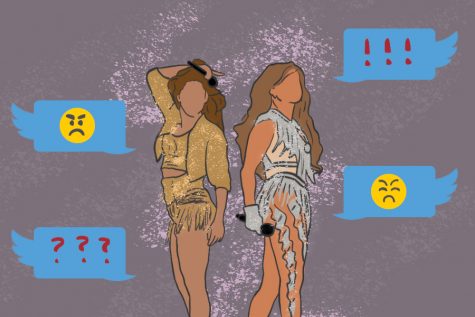OPINION: Super Bowl halftime show beautifully embraces Latinx culture
Since Shakira and Jennifer Lopez performed at the Super Bowl, people around the country are angry about the “raunchiness” of the dancing and clothes. All over Facebook, comments speak of families skipping through the halftime show, unfortunately missing the performance of the two Latina queens.

The 2020 Super Bowl halftime show marks a historic moment, as the first time the stage was occupied solely by Latinx performers. Shakira, who is Colombian, and Jennifer Lopez, who is Puerto Rican, headlined. J Balvin (Colombian) and Bad Bunny (Puerto Rican) also joined them on stage.
Many comments were in staunch support for the two women, claiming that it was empowering for Latinx women across America.
https://twitter.com/LaReinaSelena/status/1224154036657475585?s=20
The comments, however, degrading the Latinx community and the “sexuality” of the two women were rampant.
A comment saying, “Is this still America? Now, the Super Bowl halftime show is in another country’s language….good grief, that was horrible. The strippers were disgusting and the Cuban flag was terribly inappropriate.”
https://twitter.com/spanishcvndy/status/1224417998816940032?s=20
That flag was not the Cuban flag, but the Puerto Rican flag. Interestingly enough, a poll done in 2017 by Morning Consult of 2,200 adults in the United States found that only 54% of these people knew that people born in Puerto Rico are U.S. citizens.
Shakira was made fun of and mocked for the moment the cameras turned to her and she made a “tongue noise.” Shakira has Lebanese roots, and this specific utterance is a traditional Lebanese expression of joy known as the zaghrouta. It also is a reference to the Carnival de Barranquilla held in Colombia.
It was more than apparent that white Americans are uncomfortable seeing a culture represented that is anything but their own during one of the arguably most “American” events in the nation.
The very representation of the Latinx community on that broadcast reached 102 million viewers, which is a proud moment for the community in the United States, specifically for Latinx women.
There is no doubt that the Latinx population in the United States is increasing at a rapid rate. Latinx women are 38% more likely to lack health insurance than white women in the United States.
The Super Bowl brought the attention of the viewers to the beautiful cultures of the Latinx community whether people liked it or not. Shakira performed her song, “Waka Waka (It’s Time for Africa),” which became the official 2010 FIFA World Cup song. She also danced the Champeta, a dance of African descent that originated in the Colombian city of Cartagena de Indias.
Though the Super Bowl did represent a good movement for the Latinx community, it still was not a full representation of the entirety of the Latinx community. Black and indigenous populations were left out of the predominantly white performance, even though Afro-Latino dances were performed during it.
Overall, the halftime show demonstrates how Latinx culture has proudly infiltrated America’s beloved football. Though not all parts of the culture were represented, it is the beginning of a revolution that can change America. In a country that fosters very hateful discourse towards the Latinx community, the Super Bowl can represent this turning point that we need.
Americans seemed to miss the point of the Super Bowl halftime show: the importance of Latinx representation in a country that is seemingly against them.
Your donation will support the student journalists of Tulane University. Your contribution will allow us to purchase equipment and cover our annual website hosting costs.



Edward • Feb 13, 2020 at 10:25 am
Musically, the Half-Time show was outstanding. The pre-recorded tracks not only appealed to a wide audience, but truly and proudly displayed its Latin-American origins. I don’t believe the high-energy rhythms that had me rumba-ing into the kitchen for more snacks was what the problem was. I have done a lot of course work that detailed the music of the Caribbean and the Americas, including the influences of indigenous people and the invading Europeans. Not once did I come across pole dancing or crotch flashing as part of the rich history of Latin-American music. It was the far from family-friendly display that I believe most people had difficulty to accept. I, like so many across the country, was watching with my family, friends, and many children. Yes, Latin-American music can be very sensual. I just feel that a couple in formal wear performing a tango conveys a lot more passion than Jennifer Lopez spreading her legs.